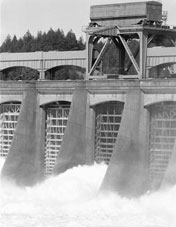Extract methane from hydroelectric dam
Brazilian scientists believe that a large amount of greenhouse gas emissions can be contained by capturing and burning methane gas released from large-scale hydroelectric dams.
The Brazilian National Space Research Institute (INPE) is developing a greenhouse gas-blocking device to penetrate the atmosphere. Accordingly, methane gas will be extracted from hydropower lakes to supplement the energy generated from the generator turbine system . It is estimated that when applied globally, this technology can significantly reduce harmful emissions to the environment, while reducing the pressure to build new hydroelectric dams in sensitive areas such as river basins. Amazon.

Due to the release of many methane, hydroelectric dams are considered one of the factors contributing to the increase in climate change.(Photo: EESC)
Environmentalists say that in the tropical regions of Brazil - where the hydropower dam system supplies more than 90% of the country's electricity needs, some reservoirs release so much methane, the density contributing to their climate change is higher than the emissions generated by fossil fuel power plants.
The methane produced is mainly caused by bacteria that decompose organic matter in low or no oxygen conditions, such as the bottom of ponds and hydroelectric reservoirs. Since the plumbing system for hydroelectric turbines is often placed deep in the bottom of the lake, under high pressure conditions, the methane gas in the water easily escapes to the outside .
'This phenomenon is the same as opening a soda bottle. The majority of methane gas dissolves in water bubbles escaping into the air. This is the reason for the large hydroelectric dams in the tropics that damage the environment , ' explained expert Fernando Ramos, project manager of INPE.
According to INPE estimates, large hydroelectric dams can generate annual global methane equivalent to about 800 million tons of carbon dioxide (CO 2 ). That is not to say that the impact of methane is not proportional to the actual mass because this gas causes a greenhouse effect 20 times stronger than CO2. INPE researchers say that with relatively simple technology, methane - an unwanted byproduct of hydroelectric production - can be converted into clean, renewable power.
The first phase of the INPE project is to prevent abundant sources of methane gas under the hydropower reservoir directly flowing into the turbine system, in order to limit the effect of ' opening the lid of the soda bottle '. To absorb methane, a floating device will pump deep water into the lake onto a closed impeller system on the water. This process creates small droplets of water that release dissolved methane. The methane gas collected will be transmitted to the treatment plant to produce electricity. In addition to creating CO2, the process of collecting and burning methane requires a lot of energy. However, INPE said that it will use hydropower energy at night when demand is low. The technology is expected to be tested later this year.
PINK SNOW
- Hydroelectric dams are discharging too much emissions?
- The construction site of the second largest hydropower station in the world
- 'Conquering' the Da River to build Hoa Binh Hydroelectricity
- Discover the world's largest hydroelectric dam
- Japan is about to exploit gas from
- Gulf Stream warm currents are releasing methane from the sea floor
- The world's largest hydroelectric dam has many consequences
- Graphene films can turn methane gas into an energy source
- The University of London developed a methane absorption spectrum
- Russia develops methane boosters
- Extract Now, extract multiple files at once
- Is the Three Gorges Dam in China deformed?
 Is the magnetic North Pole shift dangerous to humanity?
Is the magnetic North Pole shift dangerous to humanity? Washington legalizes the recycling of human bodies into fertilizer
Washington legalizes the recycling of human bodies into fertilizer Lightning stone - the mysterious guest
Lightning stone - the mysterious guest Stunned by the mysterious sunset, strange appearance
Stunned by the mysterious sunset, strange appearance